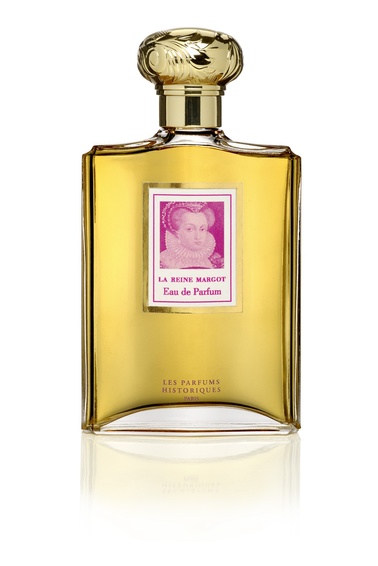Maître Parfumeur & Gantier La Reine Margot (2007) {Perfume Review & Musings} {Historical Fragrance}

La Reine Margot (Queen Margot) by Maître Parfumeur et Gantier is a beautiful, even stupendous jasmine fragrance with a strong personality. The scent strikingly develops both a sophisticated and frank animalic character softened down and made to feel like warm embers on the skin thanks to rich amber-y and soft honeyed nuances.
The jasmine is narcotic, a bit leathery, never conjuring up the flower itself, but rather its quintessence. It is like the secret aphrodisiac weapon of a free-spirited woman, Marguerite de Valois (1553 - 1615), nicknamed la reine Margot, who was only too infamous for her unbridled sensuality and lack of conformism in her sexual life.
The historian Tallemant des Réaux (1619-1692) posthumously wrote in his Historiettes that apart from her amorous excesses, she was known to be a reasonable and very witty person. But he could not but fail to transmit to posterity her extravagant quirks (he is generally thought to be correct), the fact that she was for example in the habit of carrying the embalmed hearts of her dead lovers all around herself under her vertugadin in little boxes slipped into sewn pockets. She is also reported to have regularly shaved the heads of blond male lackeys kept for that purpose, to give her the hair she lacked since she had gone bald early in her life. Her less than saintly brother king Henri III could not take it anymore at one point and threw her out of the royal court on account of her promiscuous habits (she apparently was nevertheless selective) and eccentricities. The 1994 movie La Reine Margot by Patrice Chéreau amply elaborates upon this trait of hers. Prior to that she was popularized by Alexandre Dumas' novel La Reine Margot (1845), where she is portrayed as a femme fatale.
One of the first sentences in her Memoirs published in 1658 reveals her wit,
"I shall begin these Memoirs in the reign of Charles IX., and set out with the first remarkable event of my life which fell within my remembrance. Herein I follow the example of geographical writers, who, having described the places within their knowledge, tell you that all beyond them are sandy deserts, countries without inhabitants, or seas never navigated."
(you can download an English translation of her memoirs at Project Gutenberg)....

After the two first enthusiastic words that came to mind and which were, "Wow!"and "stupendous!", the third one was "furry". What deploys itself here is not the brute, slightly gasoline-like indolic facet of jasmine (although there is a dash of that) or an impression we like to refer to as that of a "bears' pit at the zoo", but rather the sensual textural effect of a rugged warm fur, that of a beast skin that would have been thrown onto the floor-tiles of a castle in front of a gigantic fire-place to serve the erotic games of la reine Margot. La Reine Margot, the fragrance, offers a palpable archaic charm and evokes an era in which the air was laden with the many nuances of human sweat. In this perfume, the musk evokes that carnal, natural aspect of everyday social relationships in the 16th century and at the same time refines this sensation, as if the sweat had been distilled and made precious. Technically speaking, it was made to emulate the impression of macerated musk.
The perfume is based on authentic historical research conducted by 16th century specialist Janine Garrison, author of Marguerite de Valois (1994). She delved in the National Archives and the accounting documents of the château d'Usson in Auvergne, the place where la reine Margot or Marguerite de Valois was relegated for 18 years by her brother Henri III. This research consistently showed that three perfumery materials were ordered each month by Marguerite de Valois who prepared her perfume in the form of an unguent herself and they are: jasmine, amber, and musk. The press release states that,
"La Reine Margot does not correspond to the usual balance set by the olfactory pyramid, but presents itself based on a rough and head-on assembling, recreated according to 16th century techniques with only and exclusively three notes: amber, musk, and jasmine."
The fragrance was composed by perfumer Nicolas de Barry who also created the beautiful George Sand perfume in the same collection of Les Parfums Historiques. It is interesting to see that despite the economy of ingredients employed for its creation, La Reine Margot never feels simplistic, but rather rich and complex thanks to the quality of the ingredients used. It offers great balance and the blended scent is very round, seamless to the point of evoking a glow.
The perfumer had to mimic the effects of cold enfleurage for the jasmine, a technique long abandoned (see the movie Perfume for a look at that practice) as well as recreate the scent of naturally harvested musk. Both musk and amber would have been macerated at the time.
The strong impact the perfume makes on you the first time you smell it is due to the absence of fresh top notes, which would have been an anachronism at the time. Despite the fact that officially only 3 notes have been included, it includes others, noticeably some Tonka bean in the dry-down. What remains true is that the composition mainly showcases jasmine, amber, and musk. The longer dry-down smells a bit incense-y. The raw, primitive aura of La Reine Margot is undeniable yet fully engrossing. It makes one think of a time when mentalities were vastly different from ours and this is conveyed through perfume. We can still perceive the charm of that difference, appreciate its disorienting effect, and be conquered by it. It makes us think also of the effect offered by a perfume like Hammam Bouquet by Penhaligon's, which also offers a primitive, disorienting charm.
The perfume retails 72 € for 70 ml. It is currently available in the Maître Parfumeur et Gantier boutiques in France.
Images: Press release, corpus etampois










Beautiful review! The historical Margot and her entourage transported into molecules of jasmine, amber and musk... I'd love to smell this perfume. When I was a history major, the middle ages and epochs of Renaissance, Baroque and Enlightenment were my favorite...
Thank you Dusan. That's quite a number of different periods:)